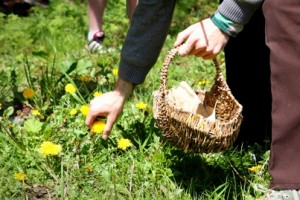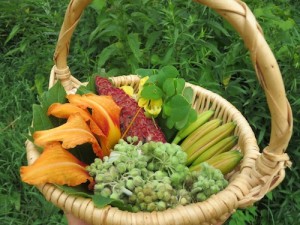The average American will eat 130 lbs of sugar every year during his or her lifetime. That’s a 650% increase over the 20 lbs per year that was consumed, on average, back in 1820. And while we all know that processed sugar is linked to a long list of health issues like diabetes, hypertension, headaches and depression it also contributes to a sort of dumbing down of our taste buds. The more sugar we eat, the more conditioned we become to it, and the less of it we actually taste.
Kenton Whitman has a lot to say on the subject of processed sugar and its stealthy partners, salt and fat. Whitman is the man behind ReWild University, a Wisconsin-based school for re-integrating human hunter-gatherer wisdom and “learning to live consciously in the world.” He’s one of a handful of people leading a movement to awaken some of our latent wild instincts and to develop an appreciation for our place in the natural world. One step in the process is rewilding how we appreciate flavor.
“Sugar actually decreases the pleasure we get from food,” Whitman says. “In very tiny amounts, it can enhance flavors, but it’s easily overused to the extent where it masks the true flavors of food. Instead of tasting the actual food, we just taste the sugar, and find ourselves craving more.”
How We Lost Our Taste
In the modern age of convenience foods, our physiological taste triggers are often used against us. Humans naturally like sweet because it represents a rare form of quick and easy energy. Back in caveman days, that surge could help our ancestors bring down a woolly mammoth or run extra fast to avoid the jaws of a hungry predator. Sugary foods were special treats and people quickly burned through the boost. Today, that can of soda, with its 11 teaspoons of sugar, isn’t doing much to help us survive.
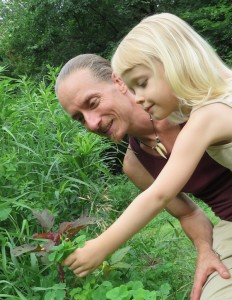
Kenton Whitman teaches his young daughter how to find and appreciate tastes found in the wild. Photo © Rebecca Whitman
Free glutamic acid is nature’s protein awareness system. When human taste buds detect that coveted umami flavor, they send a signal to the brain, telling it the food we’re eating is nutritious. On the other hand, the MSG contained in almost all processed and packaged foods–the most widely used flavor enhancer in the world, disguised by as many as 40 different names in the English language alone–is a manufactured additive designed to simulate the same positive response triggered by the naturally occurring free glutamic acid. By adding MSG, companies can make low quality ingredients taste good, because we’re tricked into detecting nutrients that aren’t there. MSG, like sugar, has been linked to a host of health problems.
Given the difference in nutritional content between a bag of Doritos and a serving of dandelion fritters, it doesn’t seem far-fetched that Sarah Hill, Rewild Portland’s “resident plant nerd and wild food aficionado” waxes spiritual about foraged foods. “When we eat wild things, it’s so much more invigorating. There is so much more power, and the vibrancy is different.”
The standard American diet has lulled many of us into craving the siren song of sugar’s empty calories and low-nutrient convenience foods masked as something satisfying. With that as our nutritional baseline, it’s hardly a stretch to imagine feeling pretty good after eating something grown in the wild.
Replenishing While Rewilding
But rewilding is more than scarfing down nuts and twigs your hipster/hippie friend has been adding to salads since before it was cool. Sarah is adamant that if one wants to return to a more native diet, we have to replenish what we use. Rewilding is also about taking care of the land.
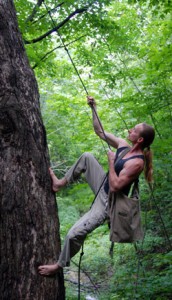
ReWild University teaches more than just what to eat. Classes include martial arts, homesteading and “the cultivation of a primal mindset.” Photo © Rebecca Whitman
“I see so many foragers or urban people who want to get the cool points of eating wild but don’t want to do the work of giving back to the land, to be in balance with the animals who also eat what they’re taking. If you don’t take care of something, you’re not going to have it later,” she warns. “You’re literally eating yourself out of house and home.” Giving back is an extra step, but it’s part of rewilding’s greater whole; learning what’s native, what’s in season, what’s abundant, where things grow and where the individual fits into their ecosystem.
Both Whitman and Hill agree that the rewilding process, itself, can take anywhere from a week to a lifetime. Breaking free from decades of conditioning by the dominant culture means, by nature, that structured guidelines and timetables are avoided. Individual people wake up to their individualities at their own pace. But Kenton says the old cravings mellow for most people after the first month.
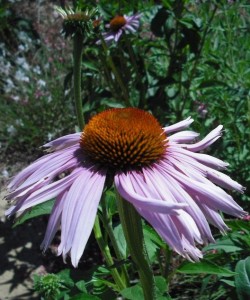
Removing 90% of your diet’s sugar and salt is not easy. But after awhile the body responds positively to foods we ate before humans were domesticated. Photo © Arianna Armstrong
When he mentors students on rediscovering their natural palate, Whitman’s first lesson is in mindful eating. Just three distraction-free minutes out of every meal focuses people’s attention on what their food really tastes like. The act of enjoying food starts to skew away from habit and toward experiencing true flavor and texture.
Next, he asks his students to remove sugar, processed foods and 90% of salt from what they eat. Rewilding isn’t part of a “diet” and it’s not about telling people what they can and can’t have, but before someone can do a hard reset, they usually have to sever their addictions and conditioning.
After one breaks free of the standard American diet, it’s easier to appreciate the flavors found in real foods. “You’ll be able to go back to eating whatever you want,” Whitman assures us. “The trick is that ‘whatever you want’ will have changed.” In other words, once a person’s taste buds are rewilded, no one will say they can’t have pizza; they probably just won’t want it anymore.
How the Garden Grows
Little by little, students are encouraged to experiment with new flavors. To try new fruits, vegetables, spices. They’re told to check out books and internet forums describing the edible plants in their community. This is where the fun begins. Hill remarks, “if you get into foraging or rewilding even just a little bit, you start seeing food all over the place.”
We ask her to name her favorite food. “Probably croissants with chocolate in them,” she answers honestly. “Or s’mores. Those are my treats.” Then she continues, “My favorite wild food is a three-way tie between acorns, chestnuts and camas root.
“Camas root is delicious,” she says excitedly. “It’s sweet. Caramel-y.”
One of the courses at ReWild Portland teaches people how to make acorn flour. Cooking with acorns is time-consuming but the results are so tasty that Hill’s family eats it quickly, even though they haven’t fully “re-wilded” yet.
Rewilding taste buds is not easy but once done can exert a profound influence on how we humans view–and value–our connection with the planet.
